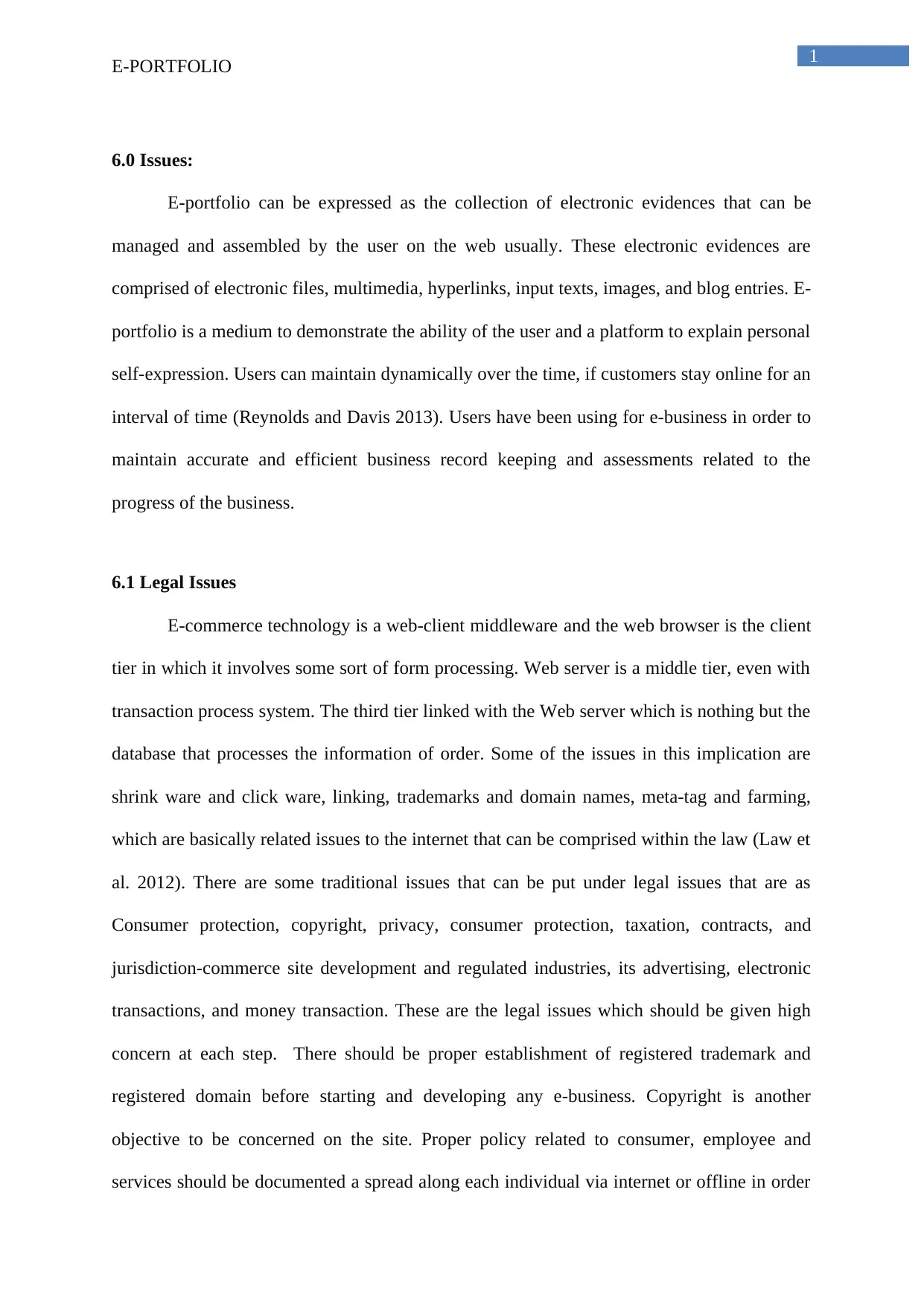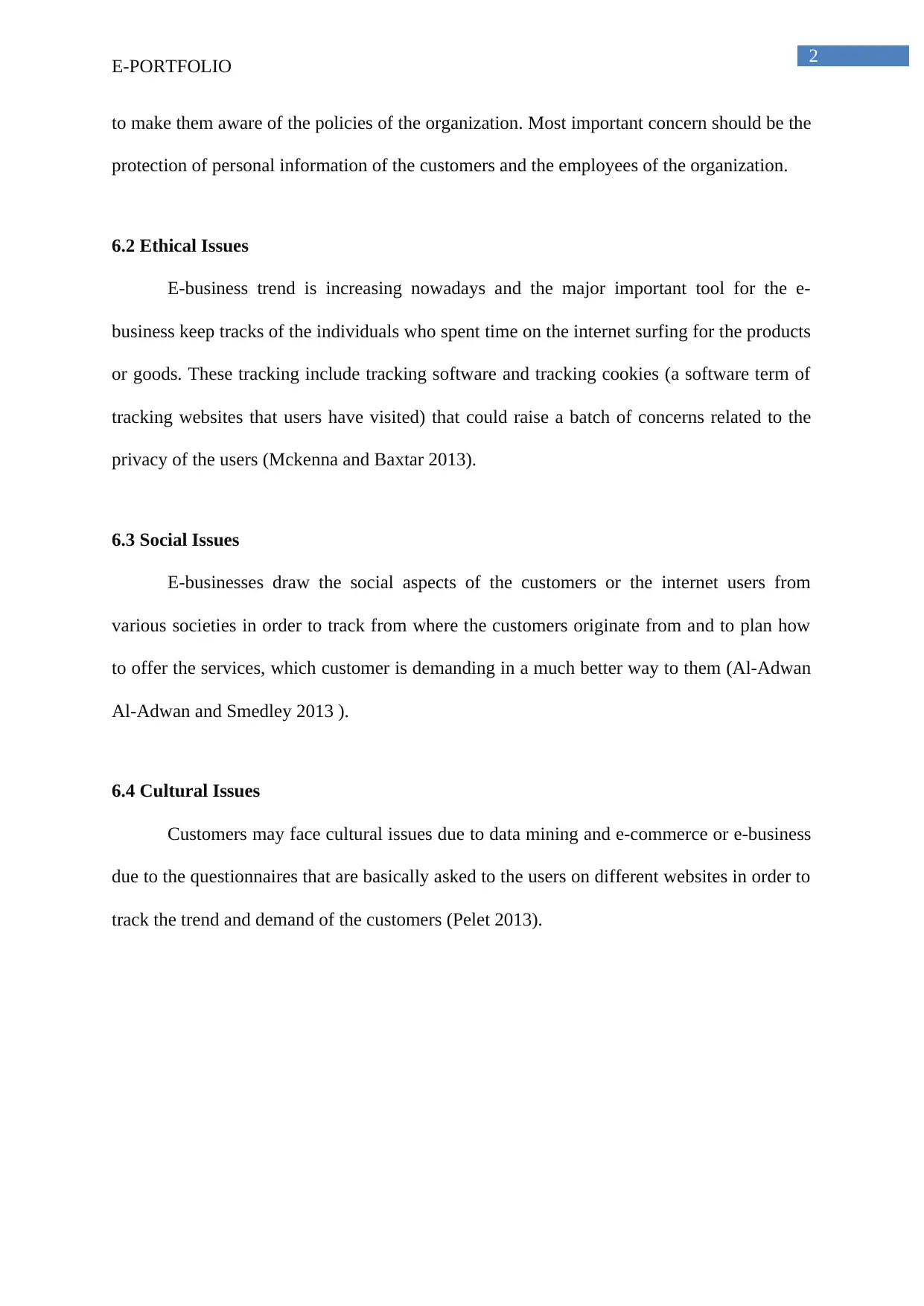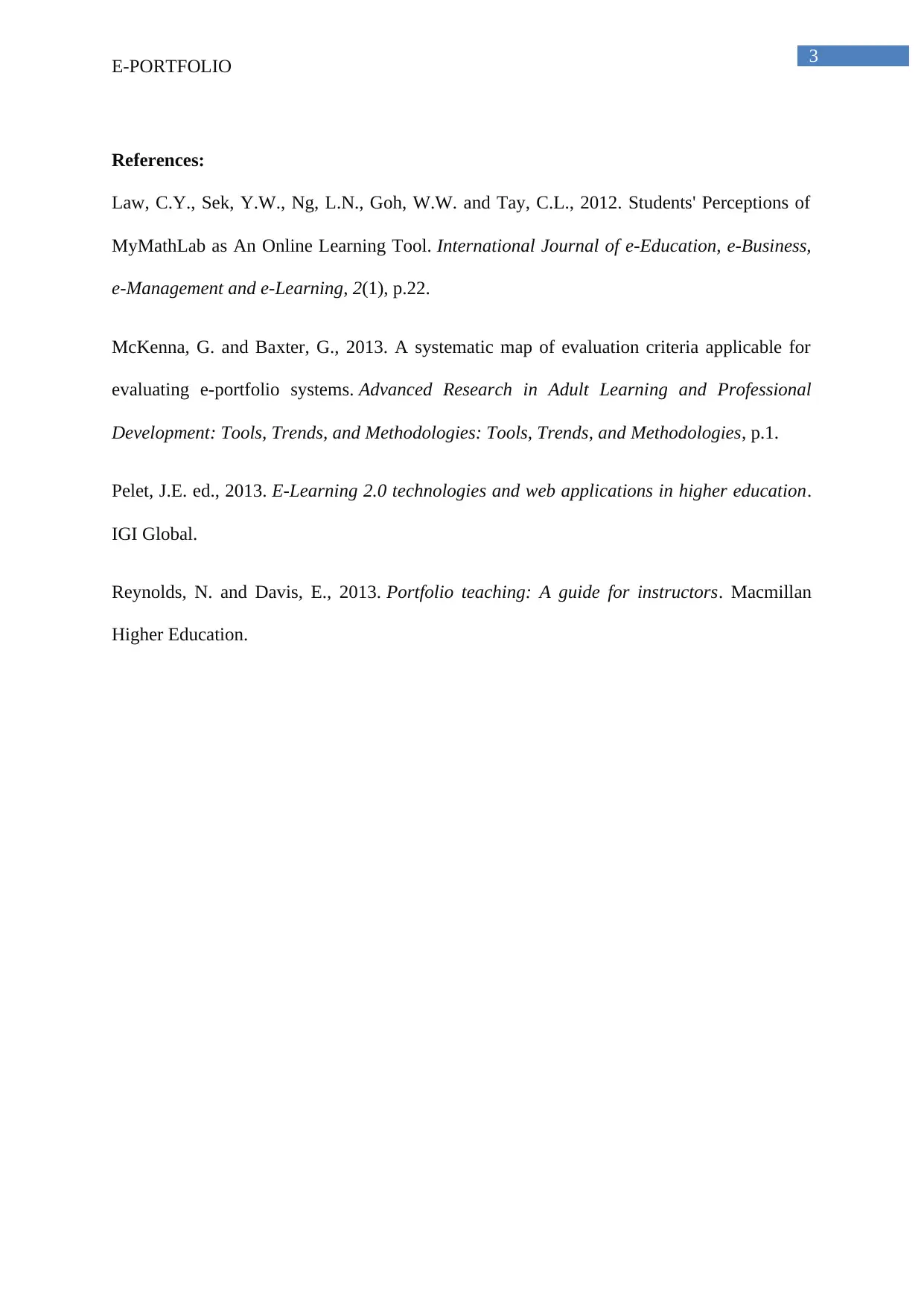E-Portfolio: Analysis of Legal, Ethical, Social, and Cultural Aspects
VerifiedAdded on 2020/02/19
|4
|709
|262
Report
AI Summary
This report examines the multifaceted issues surrounding e-portfolios, focusing on legal, ethical, social, and cultural considerations. It delves into e-commerce technology, highlighting legal aspects such as consumer protection, copyright, and privacy, along with ethical concerns related to data tracking and user privacy. The report also addresses social aspects, emphasizing how e-businesses leverage customer data, and cultural issues arising from data mining and questionnaires. References to academic sources support the analysis, providing a comprehensive overview of the challenges and considerations for businesses utilizing e-portfolios.

Running head: E PROTFOLIO
E-Portfolio
Name of the Student
Name of the University
Authors Note
E-Portfolio
Name of the Student
Name of the University
Authors Note
Paraphrase This Document
Need a fresh take? Get an instant paraphrase of this document with our AI Paraphraser

1
E-PORTFOLIO
6.0 Issues:
E-portfolio can be expressed as the collection of electronic evidences that can be
managed and assembled by the user on the web usually. These electronic evidences are
comprised of electronic files, multimedia, hyperlinks, input texts, images, and blog entries. E-
portfolio is a medium to demonstrate the ability of the user and a platform to explain personal
self-expression. Users can maintain dynamically over the time, if customers stay online for an
interval of time (Reynolds and Davis 2013). Users have been using for e-business in order to
maintain accurate and efficient business record keeping and assessments related to the
progress of the business.
6.1 Legal Issues
E-commerce technology is a web-client middleware and the web browser is the client
tier in which it involves some sort of form processing. Web server is a middle tier, even with
transaction process system. The third tier linked with the Web server which is nothing but the
database that processes the information of order. Some of the issues in this implication are
shrink ware and click ware, linking, trademarks and domain names, meta-tag and farming,
which are basically related issues to the internet that can be comprised within the law (Law et
al. 2012). There are some traditional issues that can be put under legal issues that are as
Consumer protection, copyright, privacy, consumer protection, taxation, contracts, and
jurisdiction-commerce site development and regulated industries, its advertising, electronic
transactions, and money transaction. These are the legal issues which should be given high
concern at each step. There should be proper establishment of registered trademark and
registered domain before starting and developing any e-business. Copyright is another
objective to be concerned on the site. Proper policy related to consumer, employee and
services should be documented a spread along each individual via internet or offline in order
E-PORTFOLIO
6.0 Issues:
E-portfolio can be expressed as the collection of electronic evidences that can be
managed and assembled by the user on the web usually. These electronic evidences are
comprised of electronic files, multimedia, hyperlinks, input texts, images, and blog entries. E-
portfolio is a medium to demonstrate the ability of the user and a platform to explain personal
self-expression. Users can maintain dynamically over the time, if customers stay online for an
interval of time (Reynolds and Davis 2013). Users have been using for e-business in order to
maintain accurate and efficient business record keeping and assessments related to the
progress of the business.
6.1 Legal Issues
E-commerce technology is a web-client middleware and the web browser is the client
tier in which it involves some sort of form processing. Web server is a middle tier, even with
transaction process system. The third tier linked with the Web server which is nothing but the
database that processes the information of order. Some of the issues in this implication are
shrink ware and click ware, linking, trademarks and domain names, meta-tag and farming,
which are basically related issues to the internet that can be comprised within the law (Law et
al. 2012). There are some traditional issues that can be put under legal issues that are as
Consumer protection, copyright, privacy, consumer protection, taxation, contracts, and
jurisdiction-commerce site development and regulated industries, its advertising, electronic
transactions, and money transaction. These are the legal issues which should be given high
concern at each step. There should be proper establishment of registered trademark and
registered domain before starting and developing any e-business. Copyright is another
objective to be concerned on the site. Proper policy related to consumer, employee and
services should be documented a spread along each individual via internet or offline in order

2
E-PORTFOLIO
to make them aware of the policies of the organization. Most important concern should be the
protection of personal information of the customers and the employees of the organization.
6.2 Ethical Issues
E-business trend is increasing nowadays and the major important tool for the e-
business keep tracks of the individuals who spent time on the internet surfing for the products
or goods. These tracking include tracking software and tracking cookies (a software term of
tracking websites that users have visited) that could raise a batch of concerns related to the
privacy of the users (Mckenna and Baxtar 2013).
6.3 Social Issues
E-businesses draw the social aspects of the customers or the internet users from
various societies in order to track from where the customers originate from and to plan how
to offer the services, which customer is demanding in a much better way to them (Al-Adwan
Al-Adwan and Smedley 2013 ).
6.4 Cultural Issues
Customers may face cultural issues due to data mining and e-commerce or e-business
due to the questionnaires that are basically asked to the users on different websites in order to
track the trend and demand of the customers (Pelet 2013).
E-PORTFOLIO
to make them aware of the policies of the organization. Most important concern should be the
protection of personal information of the customers and the employees of the organization.
6.2 Ethical Issues
E-business trend is increasing nowadays and the major important tool for the e-
business keep tracks of the individuals who spent time on the internet surfing for the products
or goods. These tracking include tracking software and tracking cookies (a software term of
tracking websites that users have visited) that could raise a batch of concerns related to the
privacy of the users (Mckenna and Baxtar 2013).
6.3 Social Issues
E-businesses draw the social aspects of the customers or the internet users from
various societies in order to track from where the customers originate from and to plan how
to offer the services, which customer is demanding in a much better way to them (Al-Adwan
Al-Adwan and Smedley 2013 ).
6.4 Cultural Issues
Customers may face cultural issues due to data mining and e-commerce or e-business
due to the questionnaires that are basically asked to the users on different websites in order to
track the trend and demand of the customers (Pelet 2013).
⊘ This is a preview!⊘
Do you want full access?
Subscribe today to unlock all pages.

Trusted by 1+ million students worldwide

3
E-PORTFOLIO
References:
Law, C.Y., Sek, Y.W., Ng, L.N., Goh, W.W. and Tay, C.L., 2012. Students' Perceptions of
MyMathLab as An Online Learning Tool. International Journal of e-Education, e-Business,
e-Management and e-Learning, 2(1), p.22.
McKenna, G. and Baxter, G., 2013. A systematic map of evaluation criteria applicable for
evaluating e-portfolio systems. Advanced Research in Adult Learning and Professional
Development: Tools, Trends, and Methodologies: Tools, Trends, and Methodologies, p.1.
Pelet, J.E. ed., 2013. E-Learning 2.0 technologies and web applications in higher education.
IGI Global.
Reynolds, N. and Davis, E., 2013. Portfolio teaching: A guide for instructors. Macmillan
Higher Education.
E-PORTFOLIO
References:
Law, C.Y., Sek, Y.W., Ng, L.N., Goh, W.W. and Tay, C.L., 2012. Students' Perceptions of
MyMathLab as An Online Learning Tool. International Journal of e-Education, e-Business,
e-Management and e-Learning, 2(1), p.22.
McKenna, G. and Baxter, G., 2013. A systematic map of evaluation criteria applicable for
evaluating e-portfolio systems. Advanced Research in Adult Learning and Professional
Development: Tools, Trends, and Methodologies: Tools, Trends, and Methodologies, p.1.
Pelet, J.E. ed., 2013. E-Learning 2.0 technologies and web applications in higher education.
IGI Global.
Reynolds, N. and Davis, E., 2013. Portfolio teaching: A guide for instructors. Macmillan
Higher Education.
1 out of 4
Related Documents
Your All-in-One AI-Powered Toolkit for Academic Success.
+13062052269
info@desklib.com
Available 24*7 on WhatsApp / Email
![[object Object]](/_next/static/media/star-bottom.7253800d.svg)
Unlock your academic potential
Copyright © 2020–2025 A2Z Services. All Rights Reserved. Developed and managed by ZUCOL.





